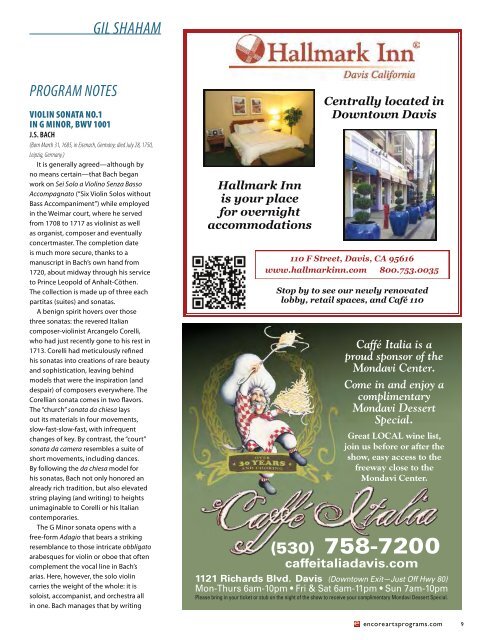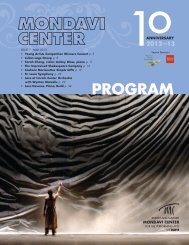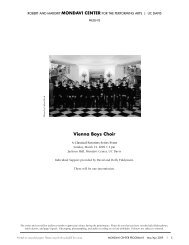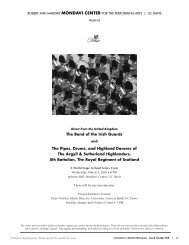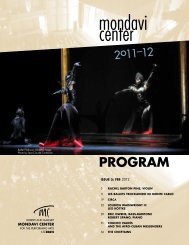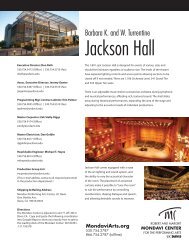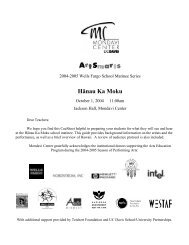NOVEMBER – DECEMBER 2013 - Mondavi Center
NOVEMBER – DECEMBER 2013 - Mondavi Center
NOVEMBER – DECEMBER 2013 - Mondavi Center
Create successful ePaper yourself
Turn your PDF publications into a flip-book with our unique Google optimized e-Paper software.
GIL SHAHAM<br />
PROGRAM NOTES<br />
VIOLIN SONATA NO.1<br />
IN G MINOR, BWV 1001<br />
J.S. BACH<br />
(Born March 31, 1685, in Eisenach, Germany; died July 28, 1750,<br />
Leipzig, Germany.)<br />
It is generally agreed—although by<br />
no means certain—that Bach began<br />
work on Sei Solo a Violino Senza Basso<br />
Accompagnato (“Six Violin Solos without<br />
Bass Accompaniment”) while employed<br />
in the Weimar court, where he served<br />
from 1708 to 1717 as violinist as well<br />
as organist, composer and eventually<br />
concertmaster. The completion date<br />
is much more secure, thanks to a<br />
manuscript in Bach’s own hand from<br />
1720, about midway through his service<br />
to Prince Leopold of Anhalt-Cöthen.<br />
The collection is made up of three each<br />
partitas (suites) and sonatas.<br />
A benign spirit hovers over those<br />
three sonatas: the revered Italian<br />
composer-violinist Arcangelo Corelli,<br />
who had just recently gone to his rest in<br />
1713. Corelli had meticulously refined<br />
his sonatas into creations of rare beauty<br />
and sophistication, leaving behind<br />
models that were the inspiration (and<br />
despair) of composers everywhere. The<br />
Corellian sonata comes in two flavors.<br />
The “church” sonata da chiesa lays<br />
out its materials in four movements,<br />
slow-fast-slow-fast, with infrequent<br />
changes of key. By contrast, the “court”<br />
sonata da camera resembles a suite of<br />
short movements, including dances.<br />
By following the da chiesa model for<br />
his sonatas, Bach not only honored an<br />
already rich tradition, but also elevated<br />
string playing (and writing) to heights<br />
unimaginable to Corelli or his Italian<br />
contemporaries.<br />
The G Minor sonata opens with a<br />
free-form Adagio that bears a striking<br />
resemblance to those intricate obbligato<br />
arabesques for violin or oboe that often<br />
complement the vocal line in Bach’s<br />
arias. Here, however, the solo violin<br />
carries the weight of the whole: it is<br />
soloist, accompanist, and orchestra all<br />
in one. Bach manages that by writing<br />
Hallmark Inn<br />
is your place<br />
for overnight<br />
accommodations<br />
Centrally located in<br />
Downtown Davis<br />
110 F Street, Davis, CA 95616<br />
www.hallmarkinn.com 800.753.0035<br />
Stop by to see our newly renovated<br />
lobby, retail spaces, and Café 110<br />
encoreartsprograms.com 9


